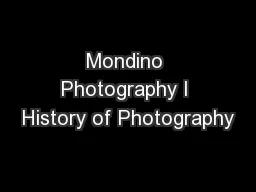PPT-Mondino Photography I History of Photography
Author : luanne-stotts | Published Date : 2019-02-03
The word photography comes from two ancient Greek words photo for quotlightquot and graph for quotdrawingquot quotDrawing with lightquot is a way of describing
Presentation Embed Code
Download Presentation
Download Presentation The PPT/PDF document "Mondino Photography I History of Photogr..." is the property of its rightful owner. Permission is granted to download and print the materials on this website for personal, non-commercial use only, and to display it on your personal computer provided you do not modify the materials and that you retain all copyright notices contained in the materials. By downloading content from our website, you accept the terms of this agreement.
Mondino Photography I History of Photography: Transcript
Download Rules Of Document
"Mondino Photography I History of Photography"The content belongs to its owner. You may download and print it for personal use, without modification, and keep all copyright notices. By downloading, you agree to these terms.
Related Documents














